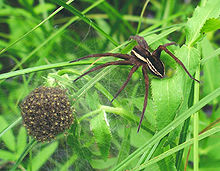Fishing spider
| Dolomedes | |
|---|---|
 |
|
| Raft spider (D. fimbriatus) female with juvenile spiders | |
| Scientific classification | |
| Kingdom: | Animalia |
| Phylum: | Arthropoda |
| Subphylum: | Chelicerata |
| Class: | Arachnida |
| Order: | Araneae |
| Infraorder: | Araneomorphae |
| Family: | Pisauridae |
| Genus: |
Dolomedes Latreille, 1804 |
| Species | |
| Diversity | |
| c. 100 species | |
Dolomedes /dɒləˈmiːdiːz/ is a genus of large spiders of the family Pisauridae. They are also known as fishing spiders, raft spiders, dock spiders or wharf spiders. Almost all Dolomedes species are semiaquatic, with the exception of the tree-dwelling D. albineus of the southwestern United States. Many species have a striking pale stripe down each side of the body.
They hunt by waiting at the edge of a pool or stream, then when they detect the ripples from prey, they run across the surface to subdue it using their foremost legs, which are tipped with small claws; like other spiders they then inject venom with their hollow jaws to kill and digest the prey. They mainly eat insects, but some larger species are able to catch small fish. They can also climb beneath the water, when they become encased in a silvery film of air. Six-spotted spiders can also walk on water to get their prey. Dolomedes is derived from the Greek word "dolomed" which means wily, deceitful.
There are over a hundred species of Dolomedes throughout the world; examples include Dolomedes aquaticus, a forest-stream species of New Zealand, the raft spider (D. fimbriatus), which lives in bogs in Europe, and the great raft spider (D. plantarius), which lives in fens, also in Europe. Many species are large, some with females up to 26 mm (1.0 in) long with a leg span of 80 mm (3.1 in).
Dolomedes spiders are covered all over in short, velvety hairs which are unwettable (hydrophobic). This allows them to use surface tension to stand or run on the water, like pond skaters. They can also climb beneath the water, and then air becomes trapped in the body hairs and forms a thin film over the whole surface of the body and legs, giving them the appearance of fine polished silver. Like other spiders, Dolomedes breathe with book lungs beneath their abdomens, and these open into the air film, allowing the spiders to breathe while submerged. The trapped air makes them very buoyant and if they do not hold onto a rock or a plant stem they float to the surface where they pop onto the surface film, completely dry.
...
Wikipedia
